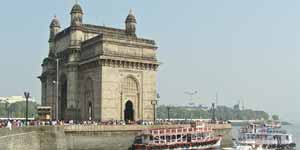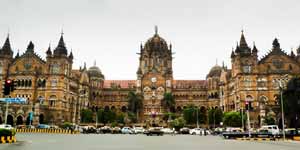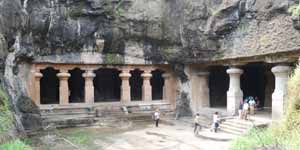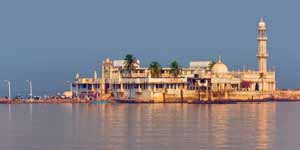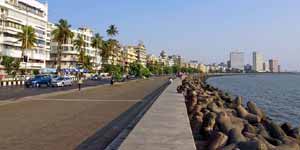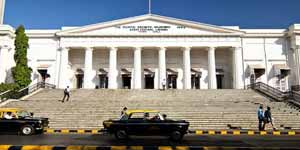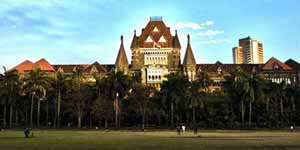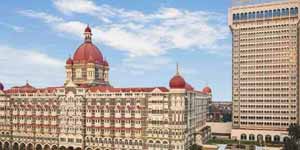
Gateway of India
The Gateway of India is synonymous with Mumbai. It is the most famous monument of Mumbai and is the starting point for most tourists who want to explore the city. Gateway of India is a great historical monument built during the British rule in the country. It was built as a triumphal arch to commemorate the visit of King George V and Queen Mary to Mumbai (then, Bombay). Gateway of India was built at Apollo Bunder, a popular meeting place. It was designed by the British architect, George Wittet.
The foundation stone of the Gateway of India was laid down by the then Governor of Bombay (Mumbai) on March 31st 1913. The archway is 26 meters high and joined with four turrets and intricate latticework carved on stones. The arch alone was built at the cost of 21 lakhs. It is built in Indo-Sarcenic style, though some influence of Gujarati style is also evident in its architecture. The structure itself is quite majestic and a hybrid of the Arc de Triomphe in Paris.
In the past Gateway of India used to be the arrival point for visitors from the west. Ironically, when the Raj ended in 1947, this colonial symbol also became a sort of epitaph: the last of the British ships that set sail for England left from the Gateway. Today this symbol of colonialism has got Indianised, drawing droves of local tourists and citizens. This landmark of Mumbai is a must visit of the city.
The Gateway faces the vast Arabian Sea, flanked by Mumbai's another attraction, Marine Drive, a road running parallel to the sea. The majestic monument is a must-visit at night, in its pristine glory against the backdrop of the sea. It is visited by millions of people across the world every year and is a very significant figure in the lives of the people of Mumbai, as the Gateway defines the grandeur of the city that is a culmination of both, historic and modern cultural environment.
History
The main objective behind the construction of the Gateway of India was to commemorate the visit of King George V and Queen Mary to Bombay (Mumbai). In March 1911, Sir George Sydenham Clarke, who was then the Governor of Bombay, laid down the monument's first foundation. Although, this plan was approved only in 1914, the reclamations at Apollo Bunder were completed only in 1919. The architectural design of Gateway of India was fashioned by architect, George Wittet. It took 4 years to complete this monument's construction.
Architectural Layout
The structural design of the Gateway of India is constituted of a large arch, with a height of 26m. The monument is built in yellow basalt and indissoluble concrete. The structural plan of Gateway of India is designed in the Indo-Saracenic style. One can also find traces of Muslim architectural styles incorporated in the structure of the grandiose edifice. The central dome of the monument is about 48 feet in diameter, with a total height of 83 feet. Designed with intricate latticework, the 4 turrets are the prominent features of the entire structure of the Gateway of India. There are steps constructed behind the arch of the Gateway that leads to the Arabian Sea. The monument is structured in such a way that one can witness the large expanse of the 'blue blanket' right ahead, welcoming and sending off ships and visitors.
Nearby Tourist Attractions
The Elephant Caves are located very close to the Gateway of India, and tourists can travel on motor boats to reach the Elephant Islands. Statues of the Maratha leader Shivaji and Swami Vivekananda are installed at the entrance of the Elephant Caves. The Taj Mahal Hotel is India's most prestigious and luxurious hotel and is situated close to the Gateway of India.
Visiting Hours
People can visit the monument at any time of the day. The best time to visit the Gateway of India is during the period of November to March, as the post-monsoon climate is very pleasant and there are very less chances for downpours at this time.
One of India's prized monuments, the Gateway of India was built in 1924. The Gateway of India is a major tourist hub in the city, which is located at Apollo Bunder Waterfront in Southern Mumbai. This monument was built to welcome King George V and Queen Mary to Mumbai and years later, the last horde of British troops left India through this gateway.
Monuments in Mumbai
Monuments in Mumbai It is a beautiful city with a vibe that can't be felt anywhere else for anyone who lives in Mumbai. Yeah, residents of other metropolitans may have raised eyebrows after my comment, but you have to agree with me that Mumbai has something to do with it! Housing India's most successful film industry; some of Asia's biggest slums, and the most expensive in the world Homes with the largest tropical forest in an urban area, the town is a true representation of the diversity that India is renowned for. Not just that, when it comes to rich history, the city can fill in pages after pages and can give any place in the country a decent run for money when it comes to nightlife. The bottom line is that Mumbai really is a city to see in India, Everything that also has your minds engaged for days after the trip. There is enough for everybody, and enough to blow up one 's mind! Without further ado, let me share a list of top places to visit in Mumbai, so if you're planning a trip to this action-packed area, you 're not even missing one part of it.


